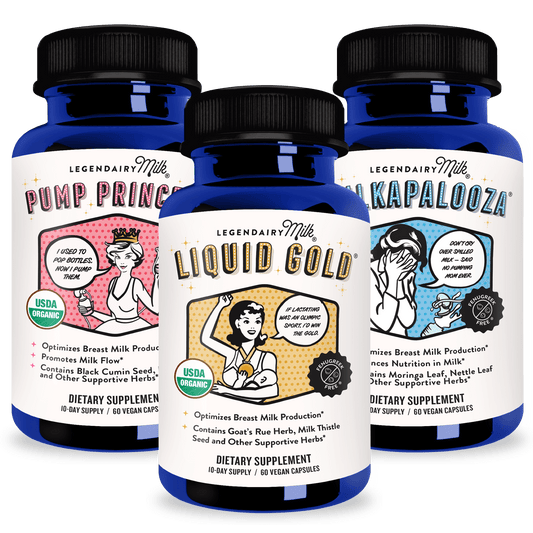Because there were generations of parents who did not breastfeed, much of our mother-to-mother wisdom about breastfeeding and fertility was not passed down. Breastfeeding rates are increasing and changing family planning methods and goals. The return of fertility and the menstrual period is widely thought to reduce milk production due to hormone shifts that occur during a normal fertility cycle. The interactions between breastfeeding behaviors and fertility hormones may not be that cut and dry. Does menstruation decrease milk production? Does decreased milk production stimulate menstruation? This is a classic chicken-or-the-egg cause-and-effect question.
The commonly shared statistic is that breastfeeding stretches the return of postpartum fertility by about 14 months. However, we all know someone whose period returned at 6 weeks, 6 months, 16 months, and 26 months. If you ask a group of parents, every experience is going to be so different, it seems unlikely that there is a “normal.” Generally speaking, the closer you adhere to the tenants of ecological breastfeeding, the greater your likelihood of delaying your period.
The term “ecological breastfeeding” refers to a group of breastfeeding behaviors that reduce the likelihood of ovulation. Some of the “rules” of ecological breastfeeding include exclusive breastfeeding without the use of pumps or bottles, meeting all sucking needs at the breast without pacifiers or bottles, frequent breastfeeding with intervals between feeds never longer than 6 hours, and no introduction of complementary foods. This type of exclusive and frequent breastfeeding is rare in the United States where many babies are supplemented within hours after birth, many parents return to work outside the home between 2-6 weeks postpartum, and lack of skilled lactation support is widespread. Statistically, this kind of breastfeeding behavior has a greater than 98% chance of preventing the return of fertility and menses for the first 6 months postpartum. That works out perfectly for those families who are reaching the exclusive breastfeeding for 6 months milestone and then starting on complimentary foods.
The symptoms of returning fertility in breastfeeding parents may include sore nipples (though there has been no change in feeding or pumping), breast or chest soreness, increased vaginal fluid, and sometimes reduced milk output. This reduction in milk may be production-related, flow-related, or both. Nipple soreness may lead to shortened feeds which leads to less milk removal which lead to reduced production. The body’s changing mineral needs during the menstrual cycle are well documented, including the relationship between calcium and premenstrual syndrome. (Link https://jamanetwork.com/journals/jamainternalmedicine/fullarticle/486599) In an effort to mitigate some of the discomfort associated with menses, many lactation consultants suggest dietary changes including the addition of nutrition supplements. Calcium taken with magnesium in a 2:1 ratio is commonly used to support milk production and flow during menses. The recommended maximum dose is 1500mg calcium to 750mg magnesium. Some parents take this mineral supplement daily while others take it from their luteal phase through cycles day three. Mineral supplementation can help with water retention, a particularly annoying symptom of the impending menstrual cycle. Water retention in the breast or chest may compromise milk production and flow as can any type of edema in the chest area.
When we think of the guidelines for ecological breastfeeding, the 6-hour maximum feed interval rule is particularly challenging to achieve for many in our modern world. Long stretches of nighttime sleep are highly valued by many families. The sleep training industry and maybe even your pediatrician encourage sleeping long stretches at night. For families that are feeding through the night, parents may take turns doing nighttime feeds, baby getting bottles of pumped breastmilk or formula at night so the nursing mother can sleep. Night nurses may be feeding the baby so the parents can sleep. Ensuring frequent nighttime milk removal is not well supported in our 9-to-5 working culture. These sleep stretches give fertility hormones the space they need to rise since the lactation hormones are falling. The reduction of milk removal, particularly during natural hormone peaks in the middle of the night, reduces the body’s overall 24-hour lactation hormone production. This is a signal to the endocrine system that the baby does not need more milk and fertility can return.
Like most things related to lactation and newborn development, prevention is easier than treatment. Closely following the guidelines for ecological breastfeeding provides your best chance to avoid the return of the menstrual cycle. Most families will not be able to follow them perfectly. However, it’s not an all-or-nothing thing. If bottles are a necessary part of your feeding plan, focus instead on keeping smaller feeding intervals. Pick the guidelines you can do and stick to them as best you can. That may change over time.
We like to think we eat well, especially during pregnancy and breastfeeding. The truth is, parents are tired and there are gaps in our nutrition all the time. If your period has returned, you’ll be expending some of your iron stores on lost menstrual blood. Getting plenty of leafy greens and vitamin C is an excellent way to support iron stores. Alfalfa (those sprouts on the salad bar) is high in calcium, potassium, and iron. It’s a traditional lactogenic food because it’s high in the nutrients needed especially during menstruation. Our lactation supplement, Cash Cow®, contains a blend of organic ingredients designed to optimize healthy lactation and enhance nutrition in breast milk - including Alfalfa and moringa. Nettle is another great green with a high vitamin C content to support iron absorption. Nettle stews have fallen out of the mainstream cuisine, but this sturdy vegetable can be found in supplement form quite easily. (Link: https://www.legendairymilk.com/collections/all/products/cash-cow-organic-lactation-blend)
Danielle Downs Spradlin, MFA, IBCLC, CLC, BRMT, NOMAS
Danielle is the lactation consultant behind Oasis Lactation Services. She focuses on whole family wellness solutions for meeting your personal breastfeeding goals. She provides telehealth lactation support globally. Reach her at OasisLactationServices.com





